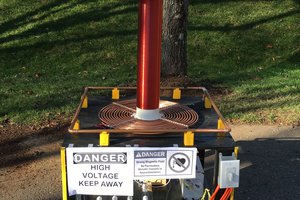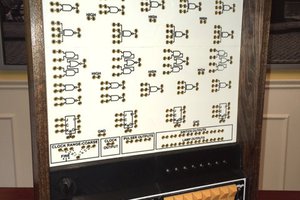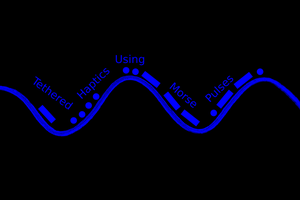Background
The Panel telephone switch was developed by Bell Labs in the 1910's, and first put into service in the early 1920's. During its heyday from about 1920 to 1940, several hundred offices were installed in large cities throughout the US. Our Panel is the last one left in the world, and served the Rainier Valley and Beacon Hill neighborhoods from 1923 to 1973. In 1986, it was removed from its home in the PArkway CO, and brought to the museum where it was lifted in by crane. It is comprised of 16 frames in 4 aisles, which is only part of its full size during its active lifetime. The frames we have allow us to run the machine and have all primary functions represented without duplicates.
The Number 1 Crossbar was installed in Seattle's LAkeview office in 1941. Though it resided in that office, its exchange was VErmont, serving the 832 office code. The No. 1 had several improvements over the Panel switch such as precious metal contacts on all relays, the expanded use of common control elements, and of course, the use of crosspoint switches instead of motor-driven hunting selectors. The No. 1 Crossbar was taken out of service in the early-mid 1970s, and moved to the museum in 1985.
Restoring Communication
Panel offices used a unique form of signaling called "revertive pulsing". This is a method of register signaling in which the terminating equipment sends pulses backwards to the originating equipment as it hunts for the appropriate terminal. This is in contrast to forward pulsing, in which the originating equipment directly pulses the address to the terminating side for connecting the call. In Panel offices, as the selectors were driven upwards by the motors, brushes attached to the vertical selector rods wiped over commutators at the top of the frame. These commutators contained alternating segments which served either as insulators or conductors. When the brush passed over a conductive segment, it was grounded, thereby generating a pulse which was sent back to the sender in the originating office to be counted. When the sender counted the appropriate number of pulses, it cut the power to the solenoid in the terminating office, and caused the brush to stop at the current position. (Wikipedia)
When the No. 1 Crossbar was initially developed, it also used revertive pulse signaling to maintain backward compatibility with panel offices. Later on, as Direct Distance Dialing was introduced, most crossbar offices were converted to use MF (multi-frequency) signaling, which used in-band tones to outpulse the dialed number from the originating equipment to the terminating equipment.
When the VErmont crossbar was brought to the museum, the revertive pulse (sometimes referred to as "RP") equipment was not included. This left the switch only capable of using MF signaling for inbound calls. As our panel only supports revertive pulse, there is no way for calls originated from the panel to reach the crossbar without large amounts of hackery. Since this option was difficult, and not historically accurate, it was not pursued.
By chance, a fellow enthusiast led me to a telephone collector in Connecticut that had the exact components we needed to enable the crossbar to signal via RP. We were shocked, as all of us thought that all of this equipment was lost or destroyed! A friend and I traveled to Connecticut, retrieved the equipment, and brought it back safely to Seattle.
 Sarah A
Sarah A
 Yann Guidon / YGDES
Yann Guidon / YGDES
 Leo Mahdessian
Leo Mahdessian
 Michael Gardi
Michael Gardi
 Lee Djavaherian
Lee Djavaherian